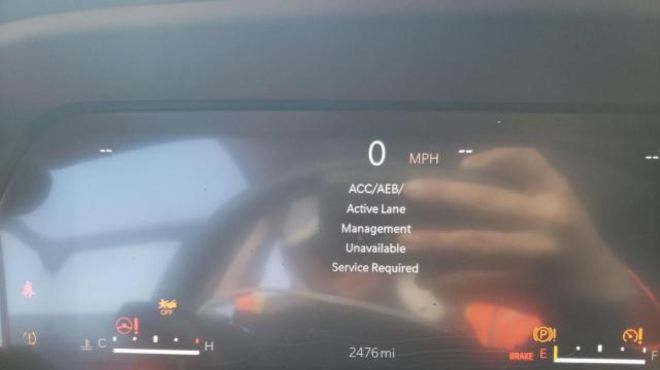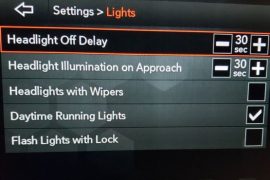You may suddenly see an alert for “Active Lane Management Unavailable Service Required” appearing in your Jeep dashboard. This confusing message is trying to tell you that your Jeep’s Active Lane Management (ALM) system has been disrupted by some factor and can no longer operate as intended.
There are a variety of potential culprits that could be interfering with service ranging from bad weather and damaged sensors to incorrect software updates or faulty vehicle wiring. Getting to the root cause requires doing some detective work to understand what forced it into the “unavailable service” mode and then addressing that specific factor.

This post will walk through the major culprits behind that foreboding warning message and the simple fixes you can try yourself to get out of the shoulder and back between the lines.
What Is the Active Lane Management System?
The Active Lane Management (ALM) system in late model Jeeps is designed to help drivers stay centered in their lane on freeways and major roads. Using a forward-facing camera behind the rearview mirror, ALM can detect lane lines on the pavement and make small steering corrections automatically to keep you within your lane markings. Think of it as a subtle helping hand to improve driving stability.
Also see – Vehicle Not In Park Message: How to Fix? (Step-by-Step)
Causes and Fixes for the Active Lane Management Unavailability
1. Adverse weather conditions like heavy rain, wind, fog, freezing temps that disrupt sensor operation
Systems like ALM rely on cameras and sensors to detect lane lines, read signs, and interpret road conditions. So when poor weather rolls in, all that high-tech wizardry can get knocked out of whack.
Heavy rain, snow, fog, hail and even extreme cold or heat can impair the forward-facing camera and other sensors involved in lane management. The sensors essentially get overwhelmed or blinded by adverse conditions, unable to correctly see lines or the surrounding environment.
It’s similar to how our eyes struggle to handle downpours or whiteout blizzard conditions when driving. If the ALM cameras and sensors can’t get a clear view of the road, they unfortunately can’t help keep your Jeep straight in the lane.
The good news is this cause of unavailable lane assist is temporary. You simply have to wait for the inclement weather to pass and conditions to clear. The ALM sensors are designed to recalibrate once visibility improves, allowing them to regain their bearings and function normally again.
So in many cases, an “unavailable service” alert due to environmental factors will sort itself out within a reasonable time. Just find a safe place to pull off if needed until the weather event ends. While inconvenient, letting the sensors reacclimate is safer than forcing them to work in overwhelmed conditions. A little patience goes a long way to riding out rain or snow disruptions!
2. Clearing Condensation, Ice and Gunk from Sensors
Aside from temporary visibility problems from bad weather, another culprit for lane assist failures can accumulate right on your vehicle’s sensors. Buildup from condensation, ice, snow melt, and road grime can obstruct the cameras and devices needed for ALM to work properly.
Just like your windshield can fog up or frost over in certain conditions, the protective housing over the forward-facing lane management camera is vulnerable too. Condensation from temperature changes or accumulated ice/slush from winter driving can literally fog or block the “eyes” of the system.
Small amounts of debris and road gunk like salt, dirt, and mud can also gradually cake onto the camera glass, distorting its view over time. The sensors essentially get blinded by all the crud, unable to collect accurate data on lane line positioning.
Thankfully, clearing away this type of sensor-disrupting buildup is straightforward. Use a soft cloth or towel to wipe down the camera housing, cleaning off any condensation, ice residue or debris that has accumulated. Be extremely gentle not to apply pressure directly on the glass. You may need to safely pull over first before attempting to reach the forward camera module near the rearview mirror.
Also inspect connections for moisture or corrosion, particularly after wet weather. Allow sensors time to dry fully if needed. With the cameras and detectors restored to clean condition, ALM can get back to unobstructed lane guidance. Staying on top of basic sensor maintenance will help nip visibility issues in the bud!
3. Issues with system activation timing/sensitivity in faded markings or construction zones
The automated systems in our vehicles can sometimes be “too helpful” for their own good. Advanced driver aids like Active Lane Management work wonders on clearly marked highway lanes, but can stumble in certain scenarios.
ALM relies on recognizing crisp painted lines on the pavement to operate properly. But what happens when those lane markings are faded, disjointed or obscured? Unfortunately the system can get confused trying to interpret missing information.
Scenarios where lane lines are faded, disjointed or obscured:
- Construction zones with partial lane markings
- Backroads with worn away paint
- City streets with lots of starts, stops and parkings
The ALM cameras need consistent visual data to engage safely. So the system will default to “unavailable” when markings are inadequate, aiming to avoid unsafe driving corrections.
While disablements in these scenarios can be annoying, they are for the best. The last thing you want is ALM making weird steering adjustments due to mixed signals!
The key is knowing when to manually disable or be extra cautious with lane centering aids. Be mindful of where and when you activate, especially in:
- Construction zones
- Areas with older/inconsistent road markings
- Complex urban streets
There’s no issue letting ALM work in ideal highway conditions. But use judgment on when to override in trickier situations until the lane markings are optimized again. Save yourself the headache and turn it off when the road layout itself provides mixed signals!
4. Sunlight overpowering the lane tracking camera system
Cameras and sensors make driving aids more advanced but also introduce their own nuances. Two tricky issues that can temporarily affect Active Lane Management are dramatic lighting changes and software-related electronic glitches.
First, the sun can actually be too intense for the ALM camera systems in certain conditions. Direct sunlight combined with the perfect angles can create overpowering glare on the lane tracking cameras. Like facing oncoming high-beams, the sensors get flooded and unable to collect reliable lane positioning data.
Thankfully this camera overload from sun glare is an easy adjustment: shift your vehicle position slightly to change the light angles. Subtle steering adjustments left or right so the cameras aren’t taking the brunt of reflections will get ALM seeing clearly again.
Also see – Dynamic Steering Torque Service Required: Causes and Fixes
5. Problems with EPS module updates interfering with system
Software hiccups can also temporarily interrupt lane aids when update glitches occur. Jeeps have an Electric Power Steering (EPS) module that translates electronic inputs into physical steering commands. When EPS firmware updates don’t take properly, connection errors can happen that disable systems like ALM.
Fixing electronic module update issues follows a simple reset process: Turn off and restart the ignition, then calibrate steering by turning wheels fully left to right. This will sync settings and reactivate connections. Finish by driving above 30 mph for over 90 seconds to let all self-checks run.
With lighting angles adjusted for sensors or electronic resets after patches, ALM will be back on track! The machine world still has its quirks but a few proper reboots typically revive automated driving aids.
6. Camera damage or obstruction leading to errors
While most Active Lane Management disruptions come from external factors, sometimes the mechanical pieces themselves fail or get knocked out of commission. Two issues to inspect if ALM problems persist are potential physical damage and loose connector problems.
It goes without saying that any sort of damage directly to the ALM camera or key sensors can cause functionality problems. Front end collisions, vandalism, and intentional abuse can break, detach or obstruct the equipment. Faulty wiring issues like frayed cables or corrosion can also impact signal connectivity.
In these hardware-related cases, corrective action involves:
- Carefully inspecting the forward-facing camera module and wiring harnesses for any signs of damage.
- Checking connectors and ports for secure fits or corrosion buildup.
- Repairing or replacing parts like cameras, sensors and cabling as needed.
7. Loose battery connectors or wiring resulting in unstable connections
Likewise, loose battery cables or equipment connectors can randomly disable ALM when contact or power gets interrupted. Vibration from rough roads can gradually wiggle connectors free over time.
Protect against wiring or connector problems by:
- Snugging battery cables and checking for tight sensor portfolio fits.
- Evaluating wiring routes away from friction points.
- Repairing any damaged wires or applying dielectric grease in troublesome plugs to maintain solid contact.
Addressing physical damage or unstable connections will get bothersome ALM issues powered back on. Don’t ignore continual system disruptions as it may indicate replacement parts are needed.
Why Diagnose? Benefits of Understanding ALM Issues
Hopefully the common causes and fixes covered shed some light on dealing with pesky “unavailable service” alerts for Active Lane Management. While having your vehicle’s automated driving aids malfunction can be temporarily annoying, there are good reasons to understand the potential triggers.
Diagnosing and addressing the various ALM disruption causes makes you better prepared from both a safety and maintenance standpoint. You can curb risks by:
- Simply disabling systems in problematic scenarios like bad weather or uneven road markings
- Taking preventative steps like cleaning sensors and inspecting wiring connections
- Recognizing when professional repairs may be the solution rather than quick fixes
Knowing the what, when and how behind system functionality empowers smarter responses. You can optimize the performance of helpful technologies like Active Lane Management when equipped with troubleshooting insights.
Steering Back on Course
In summary, Jeep’s Active Lane Management system serves an important role in stability and accident avoidance, when operating smoothly. A few common issues like weather disruptions, sensor obstructions, software hiccups or hardware failures can throw ALM offline resulting in “unavailable service” headaches.
Luckily the causes behind most lane management errors have straightforward solutions. A little patience for conditions to improve or some DIY troubleshooting like sensor cleaning, wiring checks and reboots can get ALM functional again in no time. Understanding the triggers and remedies makes overcoming the annoyances much easier.
With the insights this post provided, you now have the knowledge to maximize ALM as a driver assistance aid. No more feeling helpless when functionality falters! Instead you can take informed actions to safely reestablish lane guidance on your terms.



